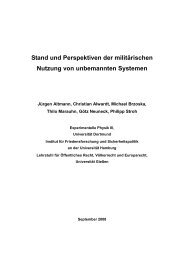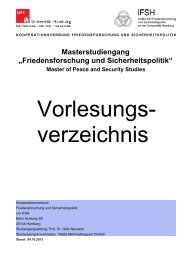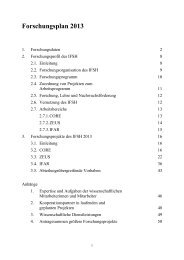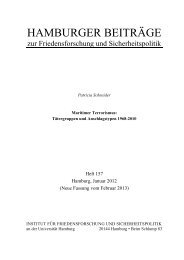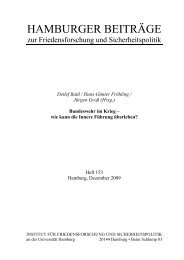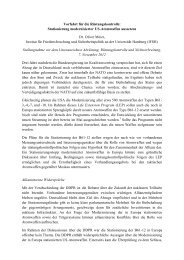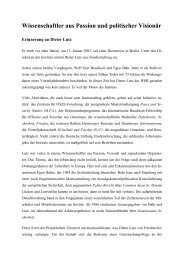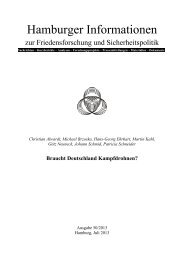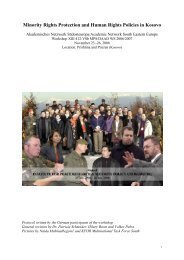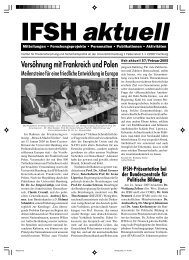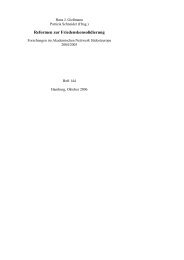New Challenges for the German Security Policy - IFSH
New Challenges for the German Security Policy - IFSH
New Challenges for the German Security Policy - IFSH
You also want an ePaper? Increase the reach of your titles
YUMPU automatically turns print PDFs into web optimized ePapers that Google loves.
The In<strong>for</strong>mation- and Media Centre of <strong>the</strong> <strong>German</strong> Armed Forces<br />
April 23, 2006. Location: Gustav-Stresemann-Institut, Bonn<br />
In <strong>the</strong> beginning, Captain Hauenstein (Seminarleitung) and Friedhelm Dauns (Sachbearbeiter<br />
Öffentlichkeitsarbeit) who are in charge of conducting seminars <strong>for</strong> <strong>the</strong> In<strong>for</strong>mations- und<br />
Medienzentrale der Bundeswehr introduced <strong>the</strong>mselves and <strong>the</strong>ir activities briefly.<br />
Second, Mr. Hauenstein in<strong>for</strong>med us briefly about <strong>the</strong> In<strong>for</strong>mations- und Medienzentrale der<br />
Bundeswehr, which is structured in three divisions: public relations, promoting secondary growth<br />
and troop in<strong>for</strong>mation. In <strong>the</strong> In<strong>for</strong>mations- und Medienzentrale der Bundeswehr archives of<br />
photographs and films of <strong>the</strong> Bundeswehr as well as of <strong>the</strong> NVA (Nationale Volksarmee) are<br />
stored.<br />
Third, after some time <strong>for</strong> first questions, we watched <strong>the</strong> film “Entschieden für Frieden, 50 Jahre<br />
Bundeswehr”. Its main message was that <strong>the</strong> Bundeswehr’s role changed since <strong>the</strong> reunification<br />
from <strong>the</strong> defense of its own and <strong>the</strong>ir allies’ frontiers to deployments abroad in cooperation with<br />
NATO (North Atlantic Treaty Organisation) and UN (United Nations Organisation). The first<br />
fighting mission of <strong>the</strong> Bundeswehr in <strong>the</strong> Balkans in 1993 represents a landmark in <strong>the</strong> history of<br />
<strong>the</strong> Federal Republic of <strong>German</strong>y and of its Armed Forces. Two conditions must be fulfilled <strong>for</strong> a<br />
fighting mission to be called constitutional: There must be a UN mandate and <strong>the</strong> parliament must<br />
have given green light <strong>for</strong> this certain action. What <strong>the</strong>n followed were <strong>the</strong> most important historical<br />
developments of <strong>the</strong> Bundeswehr between 1955, when <strong>the</strong> main goal was to have an army which<br />
would be so strong that <strong>the</strong> risk to be attacked by <strong>the</strong> Soviets was as low as possible, and 2005,<br />
when <strong>the</strong> Bundeswehr is at eye level with <strong>the</strong> o<strong>the</strong>r <strong>for</strong>ces in NATO. The challenge <strong>for</strong> <strong>the</strong><br />
Bundeswehr since 1989/90 is to trans<strong>for</strong>m itself. In a first step, troops of <strong>the</strong> <strong>for</strong>mer <strong>German</strong><br />
Democratic Republic Armed Forces (National People’s Army, Nationale Volksarmee (NVA)) had<br />
to be integrated into <strong>the</strong> Bundeswehr and <strong>the</strong> total number of soldiers had to be reduced. In a second<br />
step, <strong>the</strong> whole Bundeswehr had to be trans<strong>for</strong>med into effectively working Armed Forces which<br />
must be simultaneously ready to have fighting missions and to per<strong>for</strong>m humanitarian missions.<br />
House of History<br />
Andrea Pretis<br />
April 23, 2006, Bonn<br />
The second item on <strong>the</strong> arrival day was a visit at <strong>the</strong> Haus der Geschichte (House of History). The<br />
museum, opened in 1994, offers a permanent exhibition displaying <strong>the</strong> <strong>German</strong> history from 1945<br />
up to now. 4,000 square meters and 6,000 historical objects were awaiting us. In <strong>the</strong> entrance hall,<br />
two skilled and charming guides divided us in two groups and led us through <strong>the</strong> fascinating world<br />
of <strong>the</strong> past <strong>for</strong> one hour and a half. The journey began on <strong>the</strong> ground floor with <strong>the</strong> end of World<br />
War II. The impression of this difficult period of time streng<strong>the</strong>ned our guide by narrating his own<br />
memories as a child born during <strong>the</strong> war. Slowly we worked our way up to <strong>the</strong> top crossing<br />
decades with each floor. On <strong>the</strong> second floor we watched <strong>German</strong>y recovering itself from <strong>the</strong> war<br />
catastrophe and establishing democracy. The next levels showed <strong>the</strong> progression of <strong>the</strong> Cold War<br />
Era and its impact on <strong>the</strong> rest of <strong>the</strong> world, especially Eastern Europe. At <strong>the</strong> same time, we could<br />
admire <strong>the</strong> material and technical achievements of <strong>the</strong> proceeding 20 th century. Finally <strong>the</strong> last level<br />
was reached and <strong>the</strong>rewith <strong>the</strong> fall of <strong>the</strong> Iron Curtain, <strong>German</strong> reunification and <strong>the</strong> current period<br />
of history. The present day exposition is characterised by <strong>the</strong> challenges and commitments of <strong>the</strong><br />
globalised world. What will <strong>the</strong> new historical era look like and what will we find in <strong>the</strong> exhibition<br />
rooms of Haus der Geschichte in <strong>the</strong> coming years depends on how <strong>the</strong>se challenges will be coped.<br />
Karolina Zázvorková<br />
4



